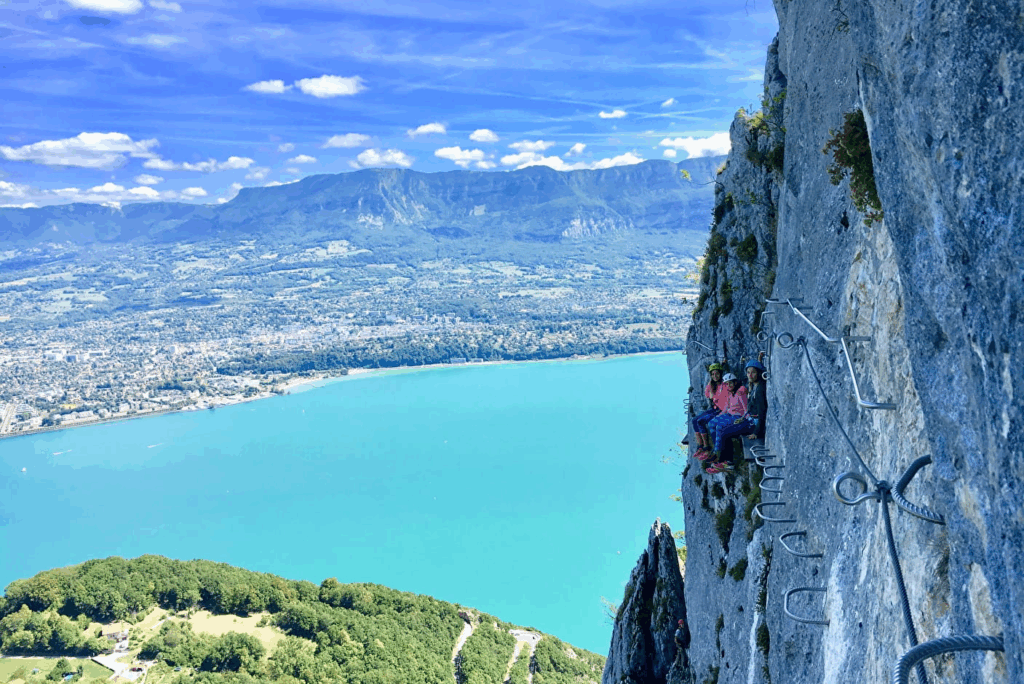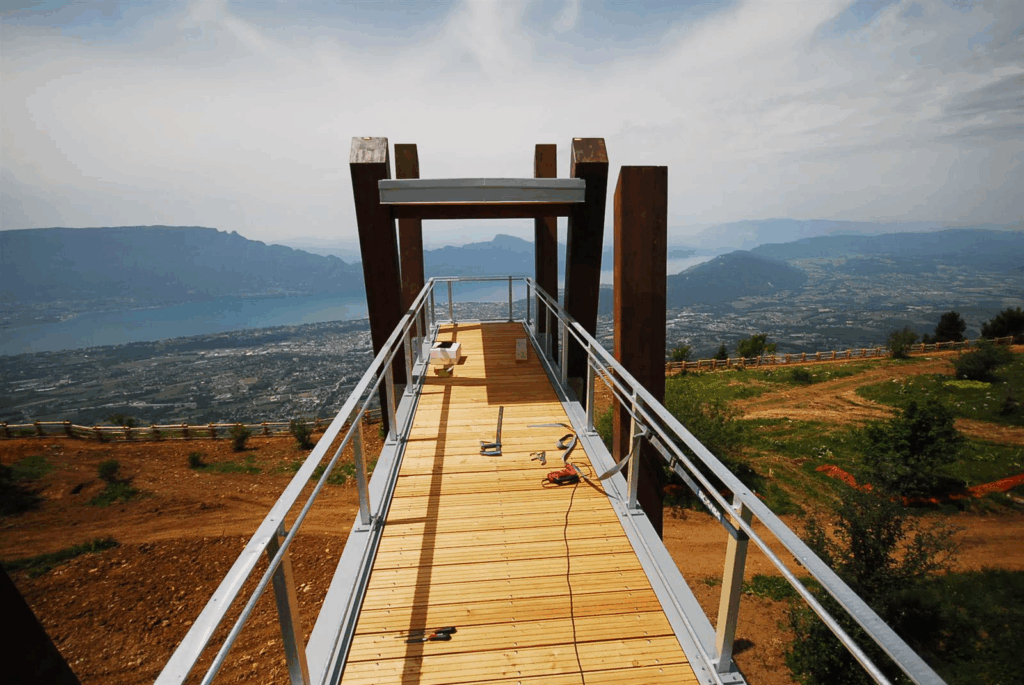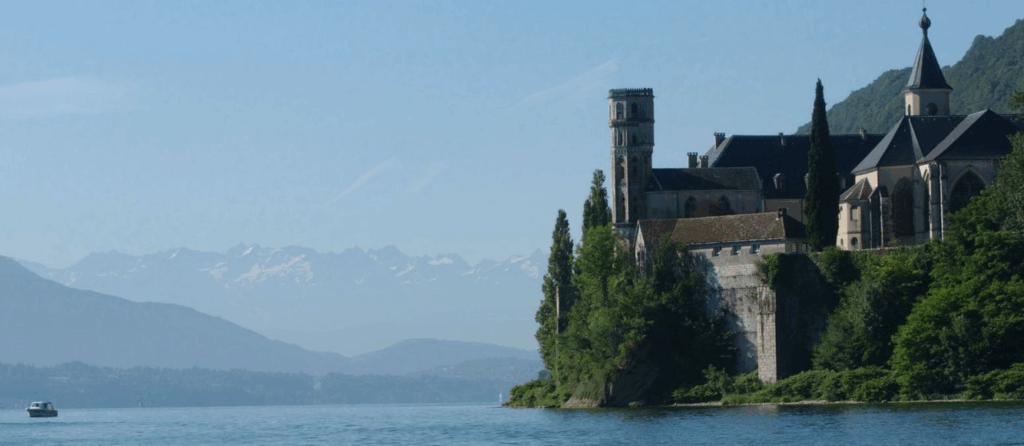Nestled majestically between the towering peaks of the Bauges massif and the Épine mountain range, Lac du Bourget—France’s largest natural glacial lake—is more than just a breathtaking landscape. Often hailed as the “French Lake Como” for its serene beauty and deep blue waters, this Savoyard treasure is also a remarkable testament to ecological resilience and pioneering sustainability efforts. Beyond its glacial origins and poetic inspiration, Lac du Bourget stands as a vibrant ecosystem and a model for environmental stewardship, demonstrating how natural beauty can thrive alongside human activity through dedicated conservation.
A Thriving Ecosystem: The Lake’s Ecological Strengths
The sheer scale of Lac du Bourget, stretching 18 kilometers long and 3.5 kilometers wide with depths reaching 145 meters, provides a vast and varied habitat for a rich biodiversity. Its cool, deep waters are home to a remarkable array of aquatic life, including various fish species, many of which are indicative of good water quality. The clarity and purity of its waters are carefully monitored, making it one of Europe’s cleanest large lakes, a testament to decades of concerted efforts.
The surrounding natural “cradle” formed by the mountains plays a crucial role in its ecological health. The more untamed western shore, with its steep cliffs of Mont du Chat plunging directly into the blue waters, acts as a vital sanctuary. This less accessible area is a refuge for remarkable flora and fauna, including several protected species that depend on this unique ecosystem for their survival. Birdwatchers can spot diverse avian species, while the terrestrial areas support unique alpine and pre-alpine vegetation. The lake’s connection to the Rhône river system also highlights its importance as part of a larger ecological network.
This intricate web of life thrives not only because of the lake’s natural geography but also due to the active protection measures put in place over the years. Conservationists and local authorities have worked hand-in-hand to ensure that both aquatic and terrestrial habitats remain undisturbed by excessive human interference. Wetlands around the lake serve as natural filtration systems, helping maintain water quality while providing nesting grounds for migratory birds. These wetland zones are protected under national and European environmental directives, reinforcing their ecological significance.
In addition to native species, Lac du Bourget is home to reintroduced populations such as the Eurasian beaver, whose presence contributes to maintaining healthy riparian ecosystems. Their dam-building activities help regulate water flow, create microhabitats for smaller organisms, and enhance overall biodiversity. Such efforts illustrate how strategic wildlife reintroductions can aid in restoring ecological balance.
Moreover, the lake serves as a living laboratory for scientists studying climate change impacts on freshwater systems. Researchers monitor temperature fluctuations, oxygen levels, and microbial communities to understand how warming trends affect aquatic life cycles. These studies contribute to broader environmental research initiatives across Europe, positioning Lac du Bourget as an important site for scientific inquiry.
Pioneering Sustainability Initiatives: Guardians of the Blue Jewel
The pristine condition of Lac du Bourget today is not merely incidental; it’s the result of decades of ambitious and collaborative environmental projects. Recognizing its immense value, local authorities and stakeholders have implemented robust initiatives aimed at preserving its delicate balance.
Wastewater Management and Lake Depollution
One of the most significant achievements has been the comprehensive effort to depollute the lake. Starting in the 1970s, substantial investments were made in collecting and treating wastewater from surrounding municipalities. Wastewater was diverted away from the lake’s direct tributaries, channeled instead to a treatment plant and then discharged downstream into the Rhône. This monumental undertaking drastically reduced nutrient input (phosphorus and nitrogen), reversing eutrophication and allowing the lake to recover its natural ecological balance. This pioneering approach set a precedent for lake management across Europe.
Today, advanced wastewater treatment facilities continue to operate with high efficiency, ensuring that effluent meets stringent environmental standards before being released. In addition, rainwater runoff from urban areas is filtered through green infrastructure such as bioswales and permeable pavements, further reducing pollution risks. These innovations reflect a forward-thinking approach to water resource management, blending engineering with ecological design.
Biodiversity Protection Programs
Active programs are in place to monitor and protect the lake’s indigenous species, both aquatic and terrestrial. This includes preserving natural spawning grounds for fish, managing invasive species, and safeguarding the habitats of protected birds and plants found along its shores and in the surrounding wetlands. Initiatives focus on ecological restoration of riverbanks and marshy areas, crucial for filtering water and providing wildlife corridors.
Collaboration between regional parks, NGOs, and academic institutions ensures that conservation strategies are backed by scientific data. Annual biodiversity assessments track population trends of key species such as Arctic char, pike, and whitefish, all of which are indicators of ecosystem health. Additionally, citizen science programs engage locals and visitors in monitoring bird migrations, amphibian breeding patterns, and water quality changes, fostering a sense of collective responsibility toward the environment.
Sustainable Tourism and Recreation
Efforts are made to balance popular aquatic activities (sailing, paddleboarding, kayaking, swimming) with environmental protection. Regulations are in place to manage boat traffic and minimize pollution from recreational vessels. Awareness campaigns educate visitors on responsible practices, encouraging respect for the natural environment. The development of eco-friendly infrastructures, such as electric boat charging stations, further supports this objective.
Tourism operators adhere to strict guidelines that limit noise pollution, prevent oil leaks, and enforce no-wake zones near sensitive habitats. Public access points to the lake are designed with minimal ecological disruption, using wooden walkways and designated viewing platforms rather than concrete structures. In some areas, visitor numbers are capped during peak seasons to prevent overcrowding and habitat degradation.
Eco-tourism initiatives have flourished, offering guided nature walks, educational workshops on freshwater ecology, and volunteer opportunities for habitat restoration. These experiences allow travelers to connect with the environment while contributing to its preservation. Moreover, local accommodations increasingly adopt green certifications, promoting energy efficiency, waste reduction, and locally sourced food options.
Land Use and Agricultural Practices
Collaborative projects with local farmers promote sustainable agricultural practices in the lake’s catchment area, reducing pesticide and fertilizer runoff that could impact water quality. Vineyards on the sunny hillsides, for example, often employ methods that minimize environmental impact while producing remarkable local wines.
Organic farming initiatives have gained traction in the region, supported by subsidies and training programs that encourage agroecological techniques. Cover crops, crop rotation, and integrated pest management help maintain soil fertility while preventing chemical leaching into waterways. Livestock farms implement rotational grazing systems to avoid overgrazing and protect riparian buffers.
These agricultural shifts not only benefit the lake but also strengthen rural economies by promoting sustainable livelihoods. Farmers participating in these programs receive technical assistance and market recognition, reinforcing the viability of environmentally conscious agriculture.
Research and Monitoring
Continuous scientific research and rigorous monitoring programs are fundamental to understanding the lake’s health and adapting conservation strategies. Data on water quality, biodiversity trends, and climate change impacts inform decision-making, ensuring a proactive approach to environmental management.
A network of automated sensors continuously tracks parameters such as temperature, pH, dissolved oxygen, and turbidity. These real-time data streams are accessible to researchers, policymakers, and the public, enhancing transparency and accountability in environmental governance. Seasonal field surveys complement this data, involving experts who assess fish populations, macroinvertebrates, and aquatic vegetation.
Climate models predict potential shifts in precipitation patterns, glacial melt rates, and thermal stratification within the lake. Scientists use these projections to develop adaptive management plans, preparing for scenarios such as increased algal blooms or altered migration patterns of aquatic species. By integrating predictive analytics with traditional ecological knowledge, Lac du Bourget remains resilient in the face of environmental uncertainty.

Exploring the Eco-Rich Landscape: Essential Places to Visit
The commitment to sustainability at Lac du Bourget enhances, rather than detracts from, the visitor experience. Exploring this region means immersing yourself in a landscape where nature and careful human stewardship coexist beautifully. Here are some key places to discover:
Aix-les-Bains
This renowned thermal spa town on the eastern shore, with its elegant Belle Époque architecture, offers a blend of historical charm and modern well-being. Its proximity to the lake allows visitors to enjoy both the therapeutic waters and the natural beauty, with an emphasis on sustainable practices within its tourism infrastructure.
Aix-les-Bains has embraced eco-friendly initiatives, including solar-powered transportation shuttles, zero-emission ferries, and carbon-neutral hotels. Thermal centers utilize geothermal energy for heating and water purification, aligning with broader sustainability goals. Cultural events in the town often highlight environmental themes, featuring exhibitions on lake conservation and climate action.
Chambéry
Just a few kilometers from the lake, the historical heart of Chambéry, the capital of Savoie, invites exploration. Its charming streets and ducal history complement the natural splendor of the lake, offering a cultural immersion that is easily accessible.
Chambéry has invested in green mobility solutions, expanding bike lanes and pedestrian zones to reduce car dependency. Local markets showcase organic produce from nearby farms, supporting sustainable food systems. The city museum frequently hosts exhibits on regional biodiversity and environmental heritage, educating residents and tourists alike.
Bourget-du-Lac
Nestled at the southern tip, this picturesque village offers an authentic ambiance. Its narrow streets, marina, and the medieval Château de Thomas II provide a glimpse into the region’s heritage, all while embracing its lakeside setting with responsible tourism initiatives.
Bourget-du-Lac prioritizes low-impact tourism, with regulations limiting commercial development and preserving historic character. Locally owned businesses emphasize seasonal menus, artisanal products, and eco-packaging. Community-led walking tours highlight ecological landmarks, fostering appreciation for the lake’s natural and cultural assets.
Mont du Chat Cliffs
On the wilder western shore, the dramatic cliffs of Mont du Chat plunge directly into the deep blue waters. This area, less accessible, is a preserved natural haven, crucial for the diverse fauna and flora it shelters. It’s a prime spot for appreciating the untouched beauty protected by conservation efforts.
Hiking trails lead to panoramic viewpoints, offering immersive encounters with alpine flora and rare bird species. Park rangers conduct guided excursions that emphasize Leave No Trace principles, ensuring minimal disturbance to the fragile ecosystem. Educational signage throughout the trail network explains the geological history and ecological significance of the cliffs.
Brison-Saint-Innocent Vineyards
The sun-drenched terraced vineyards around Brison-Saint-Innocent offer more than just scenic beauty. Here, local grape varieties thrive in the alpine climate, often cultivated using methods that are mindful of the environment, producing remarkable wines that can be tasted directly from passionate local producers.
Many vineyards in the region have adopted biodynamic and organic viticulture, avoiding synthetic chemicals and enhancing soil microbiology. Wine tastings often include discussions on sustainable farming practices, connecting consumers with the land and its stewardship. Some estates even integrate renewable energy sources, such as solar panels and biomass boilers, to power their operations.
La Dent du Chat
For hikers, ascending this peak (1390 meters) rewards with an exceptional panoramic view of the entire lake and surrounding mountains. Such trails are maintained to minimize environmental impact, allowing visitors to enjoy the natural grandeur responsibly.
Trail maintenance crews use hand tools rather than heavy machinery to preserve soil integrity. Boardwalks and stepping stones prevent erosion in sensitive areas, while informational kiosks provide guidance on ethical hiking behavior. Interpretive displays explain the geological formation of the region and the interdependence of ecosystems at different elevations.

Mont Revard
This legendary summit overlooking the lake provides one of the most stunning panoramas in Auvergne-Rhône-Alpes. Its belvedere offers sweeping views of the shimmering lake and the Alps, encouraging appreciation for the vast, protected landscape.
Mont Revard is accessible via hiking trails and cycling routes, with designated rest areas equipped with recycling bins and composting toilets. The summit hosts occasional environmental education events, bringing together experts and enthusiasts to discuss regional conservation challenges and successes.

Abbaye d’Hautecombe
This gothic architectural gem on the western shore, the necropolis of the Princes of Savoy, reflects majestically in the calm waters. Its historical significance is preserved within a setting that respects the lake’s ecological integrity.
Restoration projects at Abbaye d’Hautecombe incorporate eco-materials and passive design principles, reducing energy consumption. Guided tours emphasize the monastery’s historical ties to the lake and its role in regional cultural identity. Surrounding gardens feature native plant species, supporting pollinators and enhancing biodiversity.

A Model for the Future
The story of Lac du Bourget is one of triumphant ecological recovery and ongoing commitment. While it may retain a precious authenticity compared to its more famous Italian counterparts, its true distinction lies in its journey as a living laboratory for environmental preservation. This majestic “French Lake Como” is not just a place of stunning beauty and poetic inspiration; it’s a shining example of how dedicated ecological strengths and sustained human effort can safeguard a natural treasure for generations to come.
As global concerns about climate change, biodiversity loss, and unsustainable tourism intensify, Lac du Bourget offers a blueprint for balancing economic development with environmental responsibility. Its success demonstrates that with vision, collaboration, and community engagement, natural landscapes can flourish without compromising ecological integrity.
Local governments, businesses, and citizens continue to refine their sustainability strategies, adapting to new challenges while remaining committed to the core principles of conservation. International partnerships facilitate knowledge exchange, enabling other regions to learn from Lac du Bourget’s experiences and apply similar approaches in diverse contexts.
Educational outreach remains a cornerstone of these efforts, ensuring that future generations understand the value of environmental stewardship. Schools organize field trips to the lake, integrating lessons on ecology, history, and sustainability into their curricula. Youth programs empower students to participate in habitat restoration, citizen science, and advocacy campaigns, fostering a lifelong commitment to planetary health.
Ultimately, Lac du Bourget stands as a symbol of hope—a reminder that even in the face of environmental degradation, renewal is possible. Its crystalline waters, thriving ecosystems, and sustainable communities serve as a testament to what can be achieved when people prioritize nature alongside progress.
Related Content
- Lac du Bourget: France’s hidden alpine oasis rivals Caribbean beaches
- Lake Geneva’s Unexpected CO2 Emissions: Unraveling the Mystery
- Snowflake Wooden Spoon Baking Set
- Breakthrough in Carbon Conversion: A Leap Toward Sustainable Fuel Production
- Alert: The Weakening of the Atlantic Ocean Current Could Threaten the Amazon Rainforest
- High Pesticide Use in Costa Rica: A Call for Sustainable Farming
- The curious ‘English spa town’ in eastern France
- In the Alps, snow melts and air traffic soars
- Anne’s Chambéry, France

